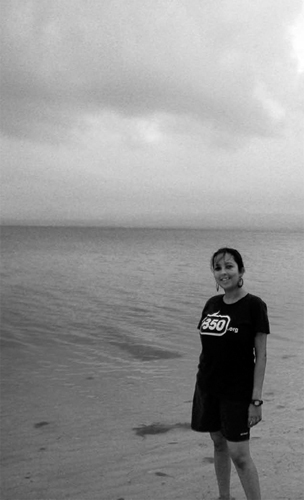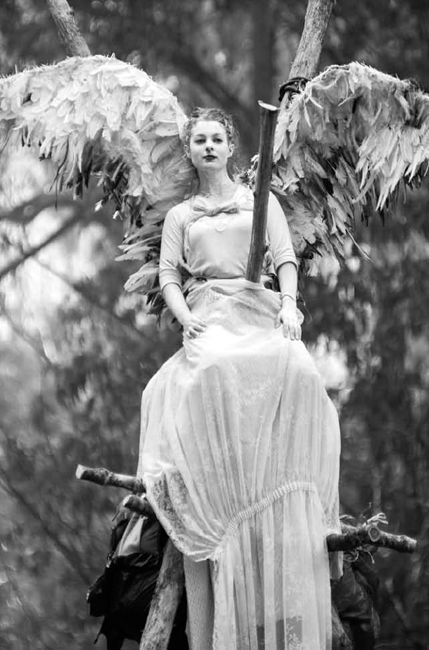The Next Eco-Warriors (13 page)
Read The Next Eco-Warriors Online
Authors: Emily Hunter
Bags packed and five flights and three continents later, I landed in cold, chilly Copenhagen of Denmark. I came to share the Pacific's story with the hope that the leaders would listen. But the first day was jarring, because there wasn't a single person that I could call my friend. I was lonely and scared, and it took time to find my bearings. Anyone could see I was brand new. I was not a seasoned campaigner or activist, but I had a story that needed to be heard. This was reinforced when I found that many of the islands were missing representatives inside the conference center.
Soon, I would get the opportunity to share my story, many times over, but the one that would stick in everyone's minds was my real moment in the spotlight. It was called the
Rainstorm Action
, an art performance inside the conference center that mimicked the flooding of island states due to climate change and gave a speaking opportunity with all the world's media paying attention. I was blown away at being given the opportunity. This was huge. This was my opportunity on the world stage. There were nerves. There was fear. Not of public speaking—I had many awards for that. But I was afraid that I might not be able to speak honestly, that I would not be able to deliver on the reality of the situation, that in that moment I would not be able to make it connect for the audience—but I needed to. Many people back home had faith that I would, and the
350.org
team was relying on me. This was the most important piece of public speaking that I had ever done, and I could not fail.
As a
350.org
member called out my name and I stepped up to hold the microphone, I thought back to my conversation with Bubu, and saw the
journey I had made since then. I was making a difference, in my own way. I knew what I did at the grassroots level was just as important as efforts on the top level, because I was helping to make a movement, which is the central force for all other change. Today, I was going to take what Bubu told me and retell it in my own way to the world.
I took a deep breath and tried. I felt as if I was getting nowhere by citing journal article facts, so I paused and asked for patience. I explained that this was a significant event and that I was overwhelmed. I was met with kind eyes from the crowd, as everyone could relate. I took another deep breath and began again. I stumbled through the most important speech of my life, concluding with:
If climate change was something we could deal with on our own, we would do so, but unfortunately we cannot. For us to save our homes from the devastation that climate change is sure to bring, we need your help. If this was war, and you asked the Islands to fight for you, you know we would, and we have. This time we need you to step up for us
.
I returned to Fiji soon after, disappointed by the failures of the Copenhagen Climate Summit. Yet as I reflect, I have come to see that the only person whose actions I can control is me. If I can make a difference, then I must. I am tired of the broken political promises, circular rhetoric, and public lip service by our world “leaders” that consistently fail to deliver any substantial change. Instead, I know now the value of grassroots activism to build a movement and revolutionize communities. This is the change one person can make; that is what I can do.
So don't give up, because I am just getting started.
_________
Subhashni Raj is currently working with
350.org
to help build a climate movement in the Pacific Island countries. She's helping the sparks fly with securing funding for climate workshops, leadership training sessions, and youth-led environmental initiatives
.

PHOTO BY SUBHASHNI RAJ
 Twenty-five
Twenty-five Australia
Australia Performance Artist
Performance Artist

PHOTO BY MATTHEW NEWTON
The difference between a soldier and a warrior is that the warrior is a lover . .
.
—MATTHEW FOX
ARRIVING ON TASMANIAN SHORES BY BOAT, I felt magic in the air. Fresh, icy wind blowing on my face from the land's ancient forested mountains. I know I need to be here, but I do not yet know I will help create a powerful and internationally recognized symbol for saving the last of Tasmania's ancient forests. Nor do I know that I will fall in love and that my life will never really be the same again.
As I stand there, embracing the moment, a tall, beautiful, and mysterious man named Ben Morrow approaches. He takes me on a tour of the forests, and it's like standing inside a cathedral of creation's most delicate sculptural masterpieces. This is enlightenment in the form of bright greens, yellows, deep umbers, and sparkling fragments of gold hovering effortlessly around me. Light refracting like crystals through dew-filled spider webs. Tiny, tweeting blue fairy wrens flutter and sweep through the ornate myrtle branches and giant flowering man ferns. The floor and walls are carpeted in soft breathing moss and lichen. And a loud echo reverberates through the forest, a sound I had never heard before:
koo koo koo koo ... koooo koo
. “That's the cry of the currawong,” Ben tells me.
He leads me down a winding stone path. Something catches my eye in the distance. I look up and witness the tallest, most majestic tree I have ever
seen. Its massive, ancient body reminds me of depictions of mammoths in museums, yet it is alive. These trees are relics of Gondwanaland, a southern supercontinent that existed over five hundred million years ago and whose land masses still exist here in parts. I had never before seen a tree of this size in my life; it must have been about three hundred feet high (91.4 meters) and possibly sixty-five feet (19.8 meters) in diameter. As I am an artist who has been passionately drawing trees since I can first remember, I wanted to capture this vision right there and then, to paint and draw the subtle white and burnt umber shades and intricate swirling patterns.
“It's a
Eucalyptus regnans,”
Ben tells me. “They are the tallest hardwood trees on Earth, and they are endemic to the southeast forests of Australia. The Weld Valley is one of the last surviving strands of this carbon-dense forest.” The compassionate tone of his voice shows me the heart-filled integrity of caring he feels for this place. Ben's eyes shine brightly, mimicking the forest's green. We look deeply into each other's eyes, as if we were long lost friends, he smiles at me, and I look away shyly with butterflies in my stomach.
I sit down to question. Where does this tree end and the ground that supports it start? Like the water that falls from the skies and flows through the streams, it is one and the same. I can start to see how each organism is a part of an interconnected and interdependent whole. I can feel it is the same relationship that we share with nature.
I follow the stony path along, greeting the ferns, flowers, and fungi with a gentle touch from my fingertips to show my appreciation. I am walking along with a spring in my step, humming a little song to myself, lost in the beauty, breathing in the pure, clean air and smelling the flowers.
Then, suddenly, to my pure shock, I find myself standing on the crumbling crust of a new logging road in Tasmania's Weld Valley, a literal hell on Earth. The air is filled with smoky smells of the burning flesh of rare animal species and ancient trees that had once been teeming with pure, unadulterated life. Before me was a whole mountainside of bare, blackened land, the equivalent of forty football fields littered with the carcasses of chain-sawed forest giants.
The air is filled with smoky smells of the burning flesh of rare animal species and ancient trees that had once been teeming with pure, unadulterated life. Before me was a whole mountainside of bare, blackened land, the equivalent of forty football fields littered with the carcasses of chainsawed forest giants
.
My heart has just been ripped from my chest and stomped on. Ben watches my utter distress as my eyes start to flood, my throat chokes up, and tingles of desperation start to resonate up my spine. “Are you okay?” he asks. I shrug my shoulders, looking at the devastation around me, trying to hold back the tears. “What can I do to stop this?” I ask, feeling low and powerless against this shattering destruction. He comes over to me and gives me a big hug and whispers in my ear a comforting comment: “A lot of people really care about the Weld Valley, and we're doing all we can to stop this madness.”
Set against this sea of forest is a curious sight: a life-sized pirate ship blocking the new logging road. The
Weld Ark
, as the ship is named, is a protest site.
What a spectacular and startling sight
, I think. This brightly painted, hand-built, life-sized pirate ship is blocking a logging road in the middle of nowhere.
To me it is like one big, living art installation resembling Peter Pan's Neverland home. Dozens of people buzz happily around the site, climbing on the ship, swinging from and living in the trees. They are stopping this road from going ahead, from cutting into a sensitive tract of wild old-growth forest in the north Weld Valley. An imposing wooden fortress barricades the area, like a medieval village. It is surreal but welcoming, and I instantly feel at home in this ancient land occupied by busy, passionate forest pirates.